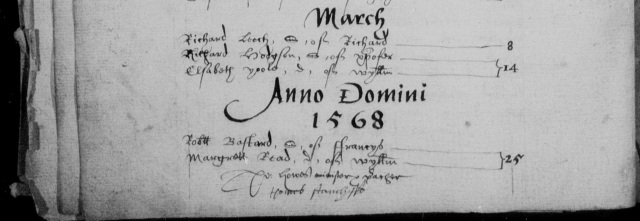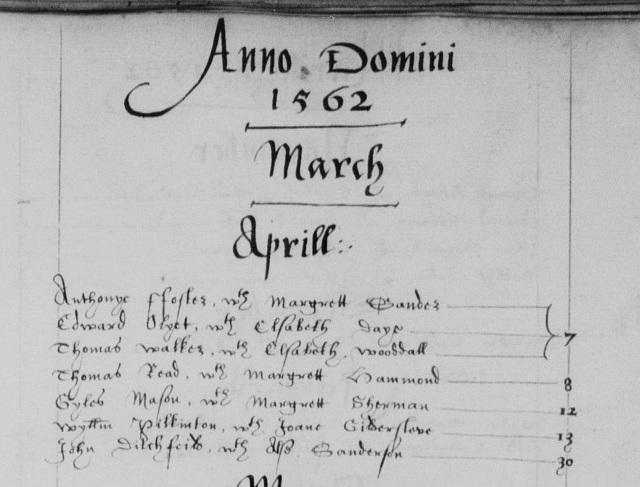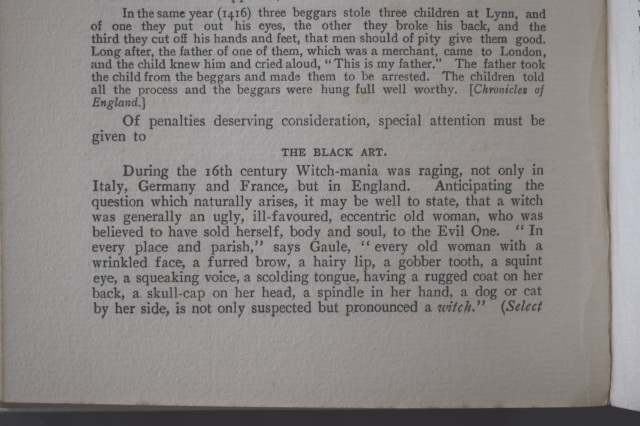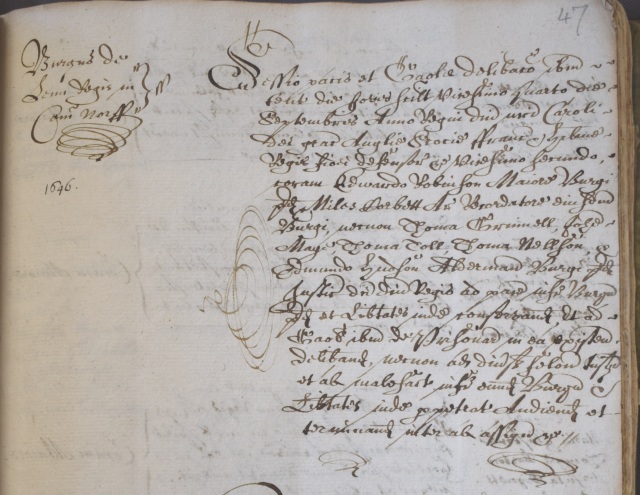It’s strange how one thing leads to another. When I was researching the French POWs in King’s Lynn, I came across Devil’s Alley, where the warehouse that was used for temporary accommodation was situated. This led on to the legend of Devil’s Alley- related in the King’s Lynn All Saints Church website:
“It is said that the devil’s hoof print is to be seen in Devil’s Alley off Nelson Street in Kings Lynn. The devil arrived by ship to the town, and disembarked to steal some souls, but he was spotted by a priest who drove him away with prayers and a dousing with holy water. The infuriated devil stamped his hoof with anger so hard that he left his imprint.”
(http://www.allsaintskingslynn.org.uk/events/sermons/devils-alley.php)
The Devil was all too real back in those days- people believed he was a physical entity who chased souls and with whom certain people- witches- could communicate. The Witchfinder General didn’t just exist in Hammer horror films. For 14 terrifying months he ran amok throughout East Anglia at considerable profit to himself “clearing towns of witches”, and indeed was invited to King’s Lynn to do just that.

Extract from the King’s Lynn Hall Book, f 187. KLBA, KL/C 7/10
It seems that, once he had reduced his victims to complete submission with techniques we now call sleep deprivation and water boarding, he asked when it was that the “witch” first communicated with the Devil.
The frenzy for witch hunting really began in the reign of James I, who apparently came into contact with it in Germany, but fear of witches had been rife decades before then- as witness the legend of the witch’s heart at number 17 Tuesday Market Place. The Market Place had long been a place for public execution, and the story goes that one witch who was burned alive in 1590 was Margaret Read. At the moment of death, her heart burst from her body, struck the wall, leaving the mark still to be seen today, then, with an energy all its own, bounced its way to the river, presumably via Page Stair Street, and plunged into the river, causing it to froth and boil.
Margaret Read was an actual person, and details can be found in the St Margaret parish register (NRO, PD 39/1). There are two possible candidates. One was baptised there on March 25th 1568.

Parish Register for St Margaret, King’s Lynn. NRO, PD 39/1
This would have made her 22 in 1590. Most witches seem to have been old women, though not exclusively so, as witness the stories of the Witches of Salem, and of Pendle Hill. The other candidate was Margaret Hammond, who married Thomas Read at St Margaret on April 8th, 1562 (PD 39/2).

Extract from Parish Register for St Margaret, King’s Lynn. NRO, PD 39/2
From researching my own family at the Norfolk Heritage Centre in the Forum in Norwich, my impression is that in those days, marriage generally happened around the age of 20, so in 1590, Margaret Hammond-Read would have been around 48 or 50, which perhaps makes her a more likely witch.
In his History of the Borough of King’s Lynn, Henry Hillen has something to say about witchcraft in general and about Matthew Hopkins. He also names a number of other witches who were executed in the 1590s.

Extract from History of the Borough of King’s Lynn, by Henry Hillen, p848
Other executions included Mary Smith, burnt in 1616, Dorothy Lee and Grace Wright, hanged in 1646, and Dorothy Floyd, or Lloyd, in 1650.
But to return to the Witchfinder General- Matthew Hopkins began his career in Manningtree, Essex, and at a time when the average worker’s daily pay was 2 pence, he was paid £23 to cleanse the town of Chelmsford of evil, including the inevitable torturings and burnings. One of his techniques was to use a pricker to test whether bite marks, scars or nipples were immune to pain, as they were reputed to be after suckling the Devil. The pricker was a three inch spike which was plunged into the victim, who of course, felt no pain, and the pricker left their flesh not having drawn blood, which was further proof. Hardly surprising, as the instrument was something like the plastic dagger I had as a child, where the blade was spring-mounted and retracted into the handle under pressure.
As indicated above, on 11th May 1646, Alderman Thomas Revitt was delegated to approach Hopkins, and there is a transcript of “Extracts from King’s Lynn Borough records relating to Matthew Hopkins’ visit to Lynn in 1646 “
The Chamberlain’s Account of 1645-6 (KLBA, KL/C 39/102) contains two entries under the heading ‘Gifts and extraordinary Charges’, for expenses of sending messengers to Matthew Hopkins.

Extract from the Chamberlain’s Account of 1645-6. KLBA KL/C 39/102
So Matthew Hopkins came to Lynn. On the 2nd September 1646 it was ordered that he be paid £15, “to be borne by the towne” (KLBA, KL/C 7/10).

Extract from King’s Lynn Hall Book. KLBA, KL/C 7/10, f 193 verso
Though later in September it was ordered that he was paid £20 “for his pains and in full discharge of his demands”:

Extract from King’s Lynn Hall Book. KLBA, KL/C 7/10, f 195
There is a book in the Archive the minutes from the Quarter Sessions where the charges against those accused of witchcraft were heard (KLBA, KL/C 21/2).

Extract from King’s Lynn Unreformed Corporation sessions minutes. KL/C 21/2
There is an entry for each of the accused, a list of witnesses, several of whom, along with Hopkins himself, seem to be giving evidence against more than one of the accused- of which more shortly- and the verdict.
Grace Wright was found guilty, and she was hanged in 1646.

Extract from King’s Lynn Unreformed Corporation sessions minutes for Grace Wright. KL/C 21/2
Thomas Dempster, Cicily Taylor, Dorothy Griffin, Katherine Banks and Emma Godfrey were all found not guilty, while the trial of Lidiah Browne was postponed, as she was, unsurprisingly given Hopkins’ methods, “not of sound mind”.

Extract from King’s Lynn Unreformed Corporation sessions minutes for Lidiah Browne. KL/C 21/2
In his History, Hillen also reports that Dorothy Lee was also hanged in 1646, and Dorothy Floyd or Lloyd in 1650- both due to the efforts of the Witchfinder. He also has a couple of other interesting facts to share. Going back to my point that a number of people seem to have given evidence against several of the accused, one is tempted to think that certain people considered themselves able to recognise witches. On page 848, Hillen mentions “the wonderfully omniscient Mrs Sparrow, who could not only detect those who had recently purloined goods, but point out the person who bewitched cows”. Was this a person of extrasensory talents, or someone with a grudge against the neighbours?
In spite of being paid handsomely by the town, though, the Witchfinder does not seem to have been very successful in King’s Lynn. If we look at the figures, seven people were brought before the court, but only one was found guilty. Apart from one who could not enter a pleas due to insanity, the rest were declared not guilty.
Vincent Price did much better!
Compiled by NRO Research blogger, Pete Widdows














A very interesting post.
Admittedly, most of my knowledge of witch trials relates to the Elizabethan period and I know that things did change somewhat under James but I am interested that you mention two cases of burning – one from the 1590s and one from 1616.
My understanding, up to this point, was that people accused of witchcraft were tried and punished for the damage they were believed to have done through ‘malificium’, not for witchcraft itself. Under the 1564 Act witches convicted of lesser counts were imprisoned; hanging was the punishment for bringing about death whether by witchcraft or any other means. Burning was reserved for the crimes of heresy and, for women, for both High and Petty Treason (such as murder of a master/mistress or husband).
Do you know what particular crimes both Margaret Read and Mary Smith were charged with?
LikeLiked by 1 person
Hi Catherine, thank you for your comments. I will contact our blogger to see if any more information about Margaret Read and Mary Smith has been discovered.
LikeLiked by 1 person
Hi Catherine,
We have just had a reply from our archivist at the King’s Lynn Borough Archives who says the following:
Sadly, the Borough Quarter session records only survive from 1620 so there is no official record of the charges held in the archives. The source Pete used was Henry Hillen’s “History of the Borough of King’s Lynn”. There is a Crime & Punishment section in volume 2 which mentions the deaths of Margaret and Mary but not the specific charges against them. The only information given about Margaret is that she was burnt in 1590.
There is some additional information about Mary. Hillen references the pamphlet, “A treatise of Witchcraft…” (the full title is a paragraph long). It was written in 1616 by Alexander Roberts who was a preacher at St Margaret’s in King’s Lynn and rector of St Peters in West Lynn and St Edmunds in North Lynn. You can view a copy of the pamphlet – http://collections.shakespeare.org.uk/search/library/83146075 – as well as a blog post about it – https://www.shakespeare.org.uk/explore-shakespeare/blogs/treatise-witchcraft-1616-alexander-roberts/ – online through the Shakespeare Birthplace trust. Hopefully it will help shed some light on the specific charge against her.
LikeLiked by 2 people
Thank you for the extra information. The pamphlet does not mention Mary’s husband as a victim, so no petty treason involved, nor does it mention the manner of her execution. I would think it would be mentioned if she had been burned. Apparently, although witches were rarely burned, even during the period covered by the Witchcraft Acts, the belief that is was the usual punishment was quite common in England. Gregory Durston in his excellent book Crimen Exceptum: The English Witch Prosecution in Context (2019) suggests that it might be tied to the folk memory of heresy burnings or an awareness of what was going on in Scotland. Memory can be a funny thing.
LikeLiked by 1 person
Hi Catherine, thanks for your reply. As you say memory can be a funny thing- it sounds like the Gregory Durston book is worth a read.
LikeLiked by 1 person
Pingback: These 10 Women Were Convicted For Witchcraft for Reasons You Won’t Believe - Myraplanet.com
Pingback: These 10 Women Were Convicted For Witchcraft For The Most Ridiculous Reasons | NTM
Pingback: Essas 10 mulheres foram condenadas por bruxaria pelas razões mais ridículas - Replicario
Pingback: These 10 Women Were Convicted For Witchcraft For The Most Ridiculous Reasons - Myraplanet.com
I really enjoyed this. I would like to know about the case of Amea Winter who was accused of witchcraft in Grimston, outside of King’s Lynn in 1626-27. I live in the United States so it’s impossible to visit safely during the pandemic. I would very much appreciate any information you could provide about her and her case. Thank you.
LikeLike
Hi Jorja,
Thanks for your question. I will ask our archivist in King’s Lynn if he knows anything about the story. Failing that you might need to pay for some research to be done into the case. I’ll let you know what our archivist advises.
Victoria
LikeLike
Hi Jorja,
I have just spoken to our archivist for King’s Lynn. He tells me that Grimston was outside the jurisdiction of King’s Lynn Borough so any records would be part of the Norfolk Quarter Sessions rather than the Lynn sessions. Sadly there is a gap in the session books between 1586 and 1629. However, the session files (Ref, C/S 3, boxes 25-26) cover the correct dates and depositions are listed among the possible contents. If you would like a search carried out of those boxes and the relevant parish registers please email norfrec@norfolk.gov.uk and we can take it from there.
Victoria
LikeLike
Thank you. I will consider this. It doesn’t seem like we would know the outcome and I have read if the charges. I appreciate your efforts to find out more information for me.
LikeLike
Thank you! I am especially wondering what the verdict was for her and her daughters.
LikeLike
Pingback: Shady Meg: The Burning Witch of King's Lynn - Icy Sedgwick